Any links to online stores should be assumed to be affiliates. The company or PR agency provides all or most review samples. They have no control over my content, and I provide my honest opinion.
I have previously reviewed the excellent EcoFlow River Max 600Wh and, more recently, the Jackery Solar Generator 1000. I have now been reviewing the latest EcoFlow DELTA 2, which was launched at IFA just a couple of weeks ago.
This is the first relatively affordable power station from EcoFlow that uses Lithium Iron Phosphate batteries, which significantly extends the life of the battery compared to Lithium nickel manganese cobalt oxides (Li-NMC) that are used on most of the other power stations and many competing brands.
| Preview | Product | Rating | Price | |
|---|---|---|---|---|

| EcoFlow DELTA 2 Portable Power Station with 1-3kWh... | £499.00 | Buy on Amazon |
Specification
- Capacity: 1024Wh
- Supports additional battery
- Battery Type: Lithium Iron Phosphate (LiFePO4)
- Battery Longevity: 3000 cycles to 80%+ capacity
- AC Output: 4x1800W total
- 2400W X-Boost
- AC Power Surge: 2700W surge
- USB-A Output:
- 2x 5V/2.4A, 12W Max per port, total 24W
- 2x Fast Charge: 5V/2.4A 9V/2A 12V/1.5A, 18W Max per port, total 36W
- USB-C Output: 2x 100W Max per port, total 200W
- Car Socket: 12.6V/10A, 126W Max
- Mains Input: X-Stream Fast Charge 1200W Max, 10A
- Solar Panel Input: 11-60V/15A Max, 500W Max
- Recharge Time: 0-80% in 60 min and 100% in 3 hours
- Net Weight: 12kg (27lbs)
- Dimensions: 400×211×281mm (15.7×8.3×11.1in)
- Warranty: 24 months – 5 year extended via registration
LiFePO4 vs Li-NMC Battery
Looking at the numbers, it is probably not worth stressing about a power station having Li-NMC vs LiFePO4, but I think it is important to highlight the importance of using this style of battery. If you plan to use the power station daily, then LiFePO4 will have some significant advantages long term.
On a normal Li-NMC battery, it will take 800 full charge and discharge cycles before the capacity is reduced to 80%+ of the original rating. That’s obviously going to last a long time, it’s 2.2 years of consecutive full charges and discharges every day. These are not like mobile phones, I probably only use my power station a handful of times per year. I’d expect a few years of use before you notice any degradation in battery performance.
However, these devices are expensive, and you want them to last as long as possible.
With the LiFePO4 on this power station, EcoFlow claims it will do 3000 cycles before you start to see the capacity drop by up to 20%. That’s 8.2 years of complete cycles daily.
If you are off the grid living and using something like this daily, then it is well worth considering LiFePO4 over Li-NMC.
Design
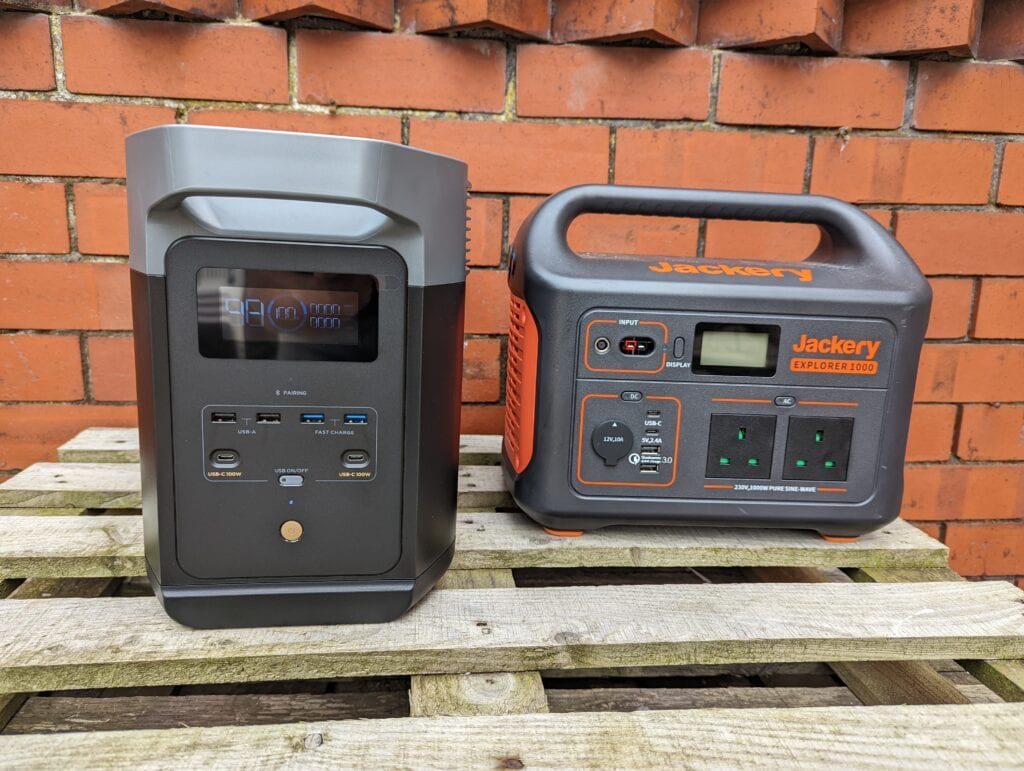
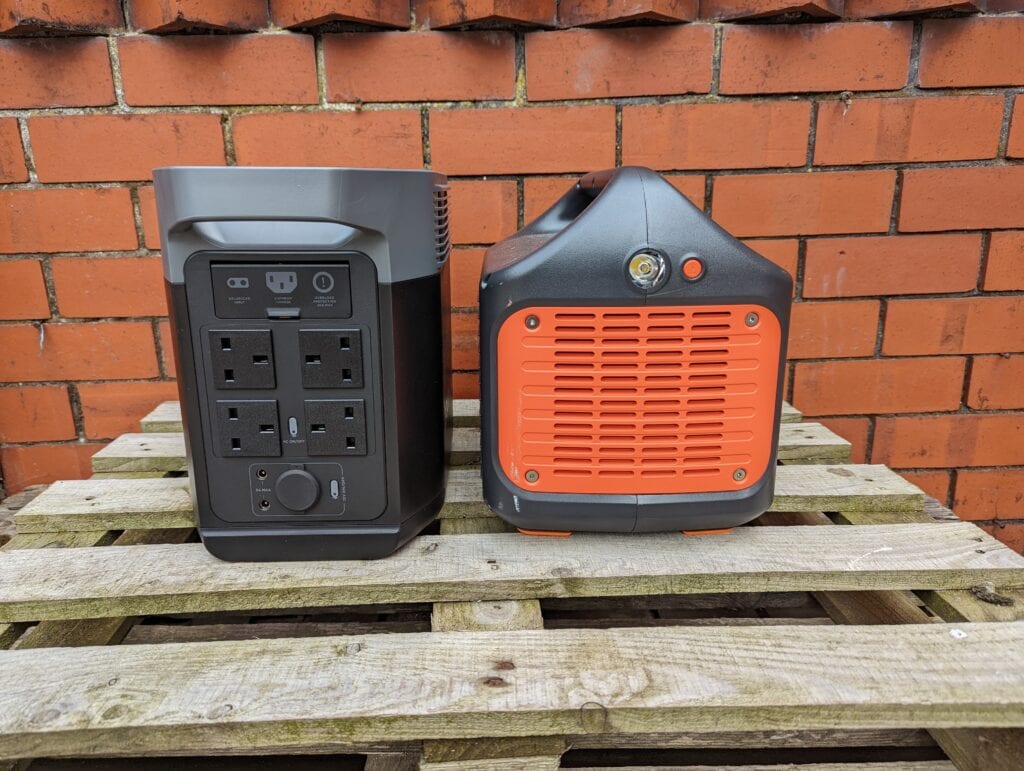
It’s a massive Lithium Iron battery; there is not a great deal to discuss with the design. But it is a little different to Jackery.
With this, you have a carry handle on either side, which makes picking up the battery and walking with it easier if you are not strong enough to lift it with one hand.
Then the ports are on either side of the unit, and the display is on the USB side of it. The port placement isn’t quite a user friendly as Jackery, and I quite often end up checking either side to work out where something is, but it is hardly the end of the world.
This then has much louder fans than the Jackery, which I assume is due to the 1200W mains charging.
It is also worth noting that the solar inputs for this are not the same as Jackery, so I was unable to plug the SolarSaga 100W into this.
Battery Expansion
One unique feature that sets this apart from the competition is the ability to extend the battery capacity. This can be either via the £750 DELTA 2 Extra Battery, which is basically the same spec as the DELTA 2 but with only one output port used to connect the two devices together. Or, there is the £1500 DELTA Max which extends the capacity a further 2016Wh.
I can’t say how much use that is, but having the option is always nice. At the very least, it allows you to extend the capacity to almost the equivalent of the 3600Wh DELTA Pro for a total cost of £2600 vs £3500. You’d also have the flexibility of one semi-portable battery you can take travelling with you while having the extended storage a much larger stay-at-home power station has.
App and Settings
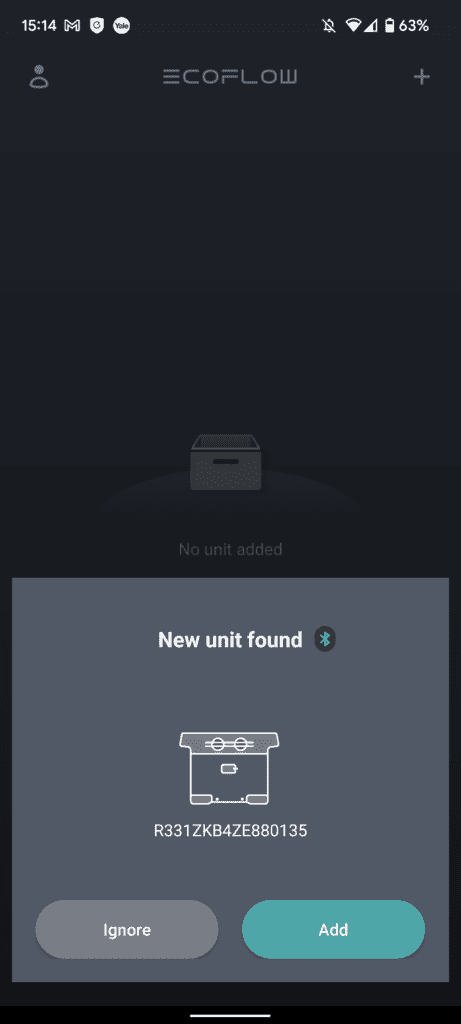
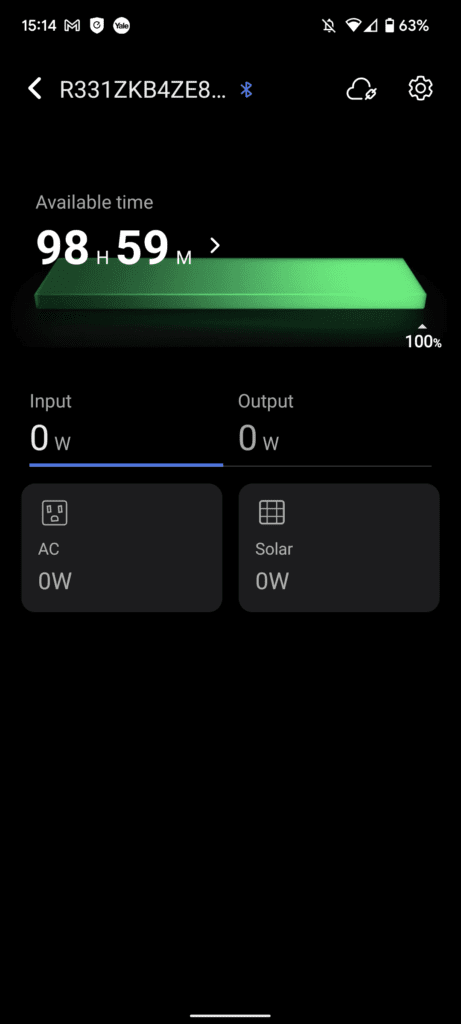
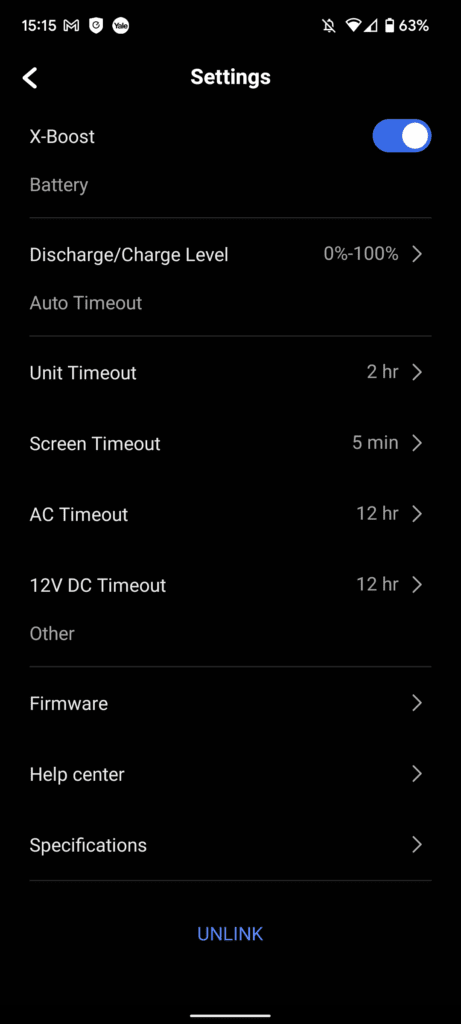
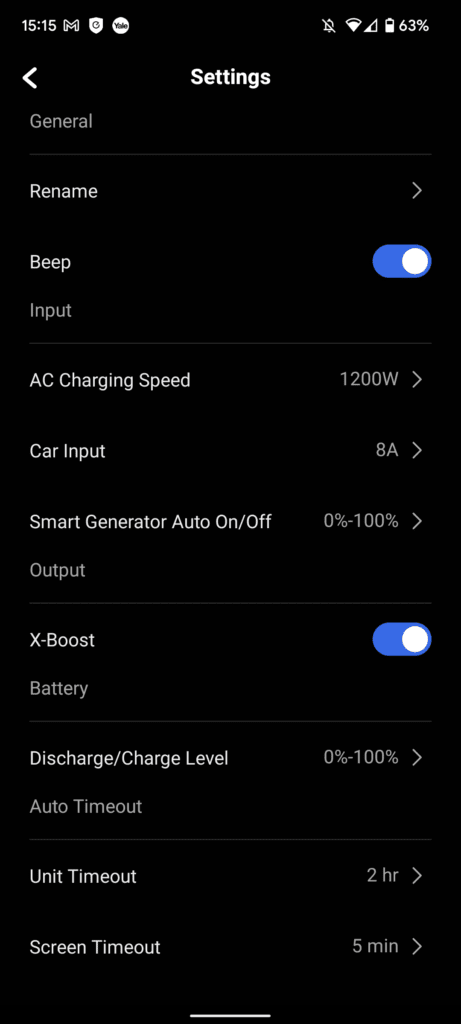
Having an app and a power station with WiFi connectively seems a bit unnecessary, but it gives you additional settings that you can control easily.
The basic main page lets you know the current length of time before the battery runs out. What the input and output are, and also, what the input speed is for either AC or solar.
Then within the settings, you can set the AC charge speed, car input speed, as well as enable/disable the X-Boost function.
Solar Charging
My DELTA 2 arrived in September when the weather had started to become a bit glummer, and I wasn’t able to make the most of the sun as I did with the Jackery.
EcoFlow didn’t supply a solar panel, and I couldn’t use the SolarSaga 100W, so I used the Mobisolar 100W foldable portable solar panel. Due to the weather, I wasn’t able to get the same consistent solar charging as I did with the Jackery but I still managed to exceed 60W for shorter periods of time.
Using the EcoFlow solar panels, you can, in theory, charge this with up to 500W solar. A single EcoFlow 400W solar panel will set you back around £1000. That’s a lot of money, but my entire house draws about 800W when I work at home, so a 400W panel could easily keep someone going during the day in an off-grid set-up.
Mains Charging
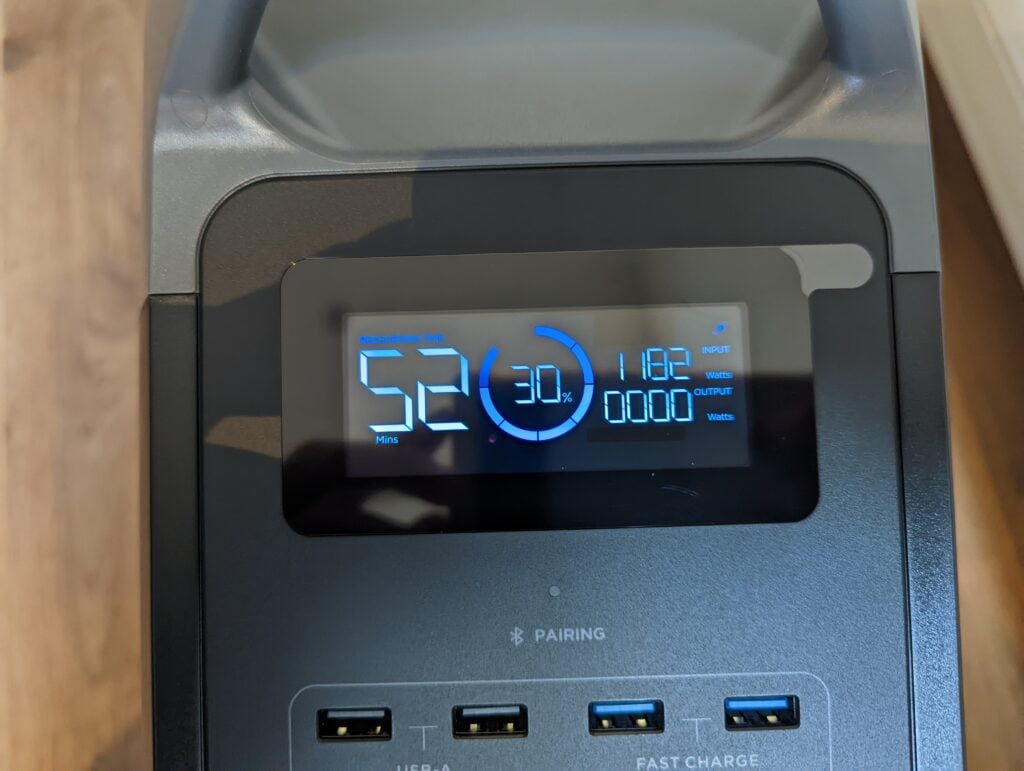
With this plugged into the mains, it can charge up to 1200W, which is significantly faster than the Jackery power stations I have reviewed.
My EcoFlow DELTA 2 arrived with 30% charge, and when I plugged it in, it informed me it would take just 51 minutes to charge fully. The Jackery will take 7.5 hours, going from 0% to 100%.
The downside to this incredibly fast charging is that the power station will spin up its cooling fans immediately, and they are quite loud. You are not going to get away with discretely charging this in a café at full speed when trying to live off-grid.
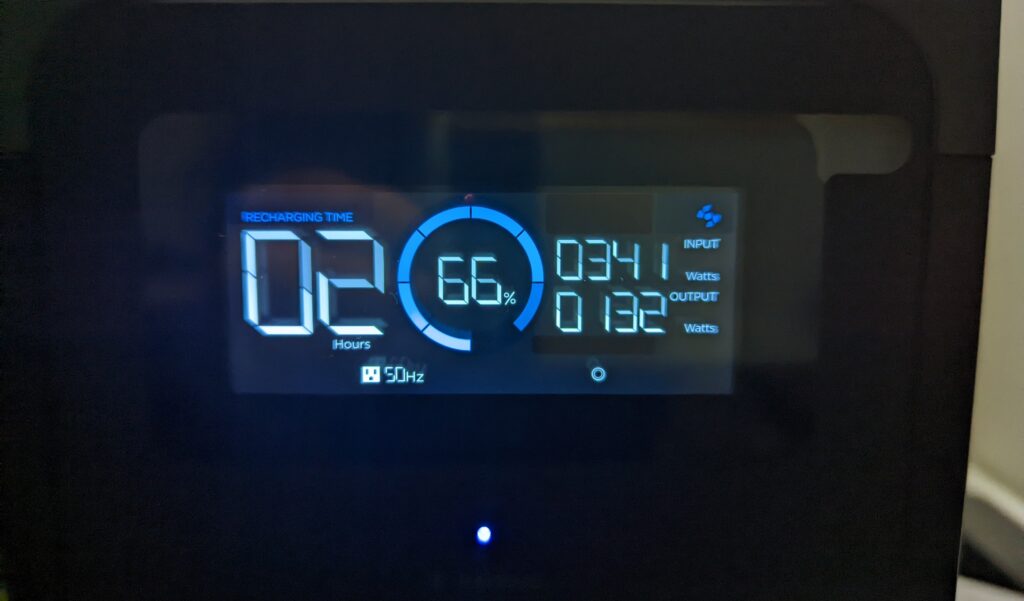
It is possible to set the charge speed within the app, and I expect the fans will reduce at lower speeds. I reduced the charge to 200W when using it with my PC, and the fans significantly dropped in noise but still stayed on. The fan noise was louder than my PC, and higher pitched.
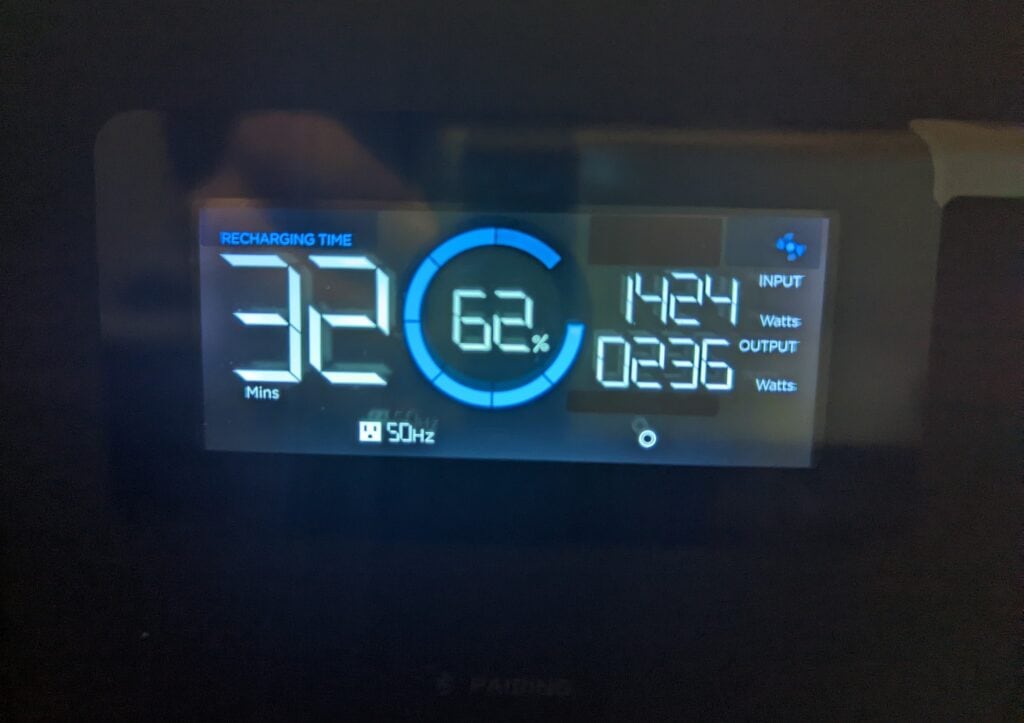
If you have a device plugged in, it looks like the EcoFlow will pull extra power from the wall to account for the devices plugged in. With my PC plugged in and the charge set to 200W, I was seeing 340W. With no limit set in place for charging, it drew 1420W. I assume this is because it was drawing 236W and powering the PC directly while also drawing near the maximum 1200W to charge the battery.
It is also worth noting that the included kettle lead for this power station is specially rated to handle very high power. You should therefore keep this cable safe and make sure you always use it with the EcoFlow.
Peak Output and X-Boost
Another attractive feature of the EcoFlow power stations is the X-Boost function which allows the power station to achieve a peak output of 2400W rather than 1800W.
While the inverter itself can only do 1800W, the X-Boost regulates the voltage down for higher power down, allowing you to run a 2400W device at 1800W, whereas most other power stations would run for a few seconds before the surge protection kicks in. This would obviously reduce the performance of the device in question, for example, a kettle will take longer to boil. Similarly, some devices will just not work, but they have strict voltage requirements.
100W Power Delivery USB-C Charging
You get six USB ports in total. Two are normal 12W USB-A then two 18W fast charging USB-A.
Then the two USB-C ports below those can do 100W. This is quite an important feature for me as it allows me to charge most modern laptops without taking a dedicated power delivery plug with me.
Testing and UPS Mode
I have tested this in a variety of conditions, with it working perfectly in all scenarios, which is the minimum you expect for this type of device.
- Just like the Jackery, I ran this for 24 hours running an under-the-counter fridge, with a similar result of around 50% usage during that time.
- I was unable to find my USB power tester but the power station easily charged my Honor MagicBook 15 laptop directly through the 100W PD ports.
- I also took it away with me for a lad’s weekend and used it to power two PerfectDraft machines and my Alpicool K25 car fridge. It was only used for a few hours in this scenario before the rain made us bring everything inside.
- I then used it to power my work PC both completely on the battery and in the UPS mode.
- For UPS mode, the EcoFlow will automatically detect that it is plugged in and provide power from the grid, not the battery. When power gets disconnected, it will switch to the battery. However, the switch time is <=30ms, not 0ms switching, and therefore may not be suitable for some devices.
- To test the UPS switching, I unplugged the EcoFlow while my PC remained on, and things continued to work as expected.
Price and Alternative Options
The EcoFlow DELTA 2 retails for €1,199 or £1,099.
| Preview | Product | Rating | Price | |
|---|---|---|---|---|

| EcoFlow DELTA 2 Portable Power Station with 1-3kWh... | £499.00 | Buy on Amazon |
For US buyers, there is a 5% off discount coupon which is valid from 16th Sep-2nd Nov:
- 5% OFF Coupon code: EFDELTA2
The original EcoFlow DELTA is £1150 but has a superior capacity of 1260Wh and 1800W output with 3300W surge, but the battery is Li-NMC.
The Jackery Portable Power Station Explorer 1000 is priced at £1,154.99, the spec isn’t quite as good, but they are the most reputable name in the game.
The Anker 757 Portable Power Station is the largest power station Anker does, with a capacity of 1229Wh using LiFePo4. It is quite expensive at £1,399, but you can get 10% on the Amazon page.
BLUETTI don’t do anything in the 1KWh range, but they use LiFePO4 on almost all of their power stations. The AC200P has 2000W and is priced at £1700, or the EB70 has 716Wh for around £700.
The PowerOak EB120 has a 1200Wh battery for £1,000 and seems to be a lower spec brand within the BLUETTI.
Then there is the ALLPOWERS 2000W Portable Power Station, which actually only has 1500Wh and costs £1500.
Overall
The EcoFlow DELTA 2 is a superb power station with a specification and price that is superior to most of the competition.
The LiFePO4 battery should mean this will last you many years without a significant drop in battery capacity. This makes it an ideal choice for heavy users such as people using these extensively for off-the-grid living, like canal boats or van-lifers. This comes at a slightly premium price over the original EcoFlow DELTA. That has 23% more capacity for just £50 extra or 4.5% extra. Personally, I would prefer the reassurance of LiFePO4 longevity, but, in reality, considering my usage, I would probably never notice the difference in performance.
EcoFlow DELTA 2 Portable Power Station Review Rating
Summary
The EcoFlow DELTA 2 is a superb power station with a specification and price that is superior to most of the competition. The LiFePO4 battery should mean this will last you many years without a significant drop in battery capacity. This makes it an ideal choice for heavy users such as people using these extensively for off-the-grid living, like canal boats or van-lifers.
Overall
95%-
Overall - 95%95%
Pros
- LiFePO4 battery will last many years
- Fast charge speeds
- High solar input capacity
Cons
- Lower capacity for your money than the original DELTA
I am James, a UK-based tech enthusiast and the Editor and Owner of Mighty Gadget, which I’ve proudly run since 2007. Passionate about all things technology, my expertise spans from computers and networking to mobile, wearables, and smart home devices.
As a fitness fanatic who loves running and cycling, I also have a keen interest in fitness-related technology, and I take every opportunity to cover this niche on my blog. My diverse interests allow me to bring a unique perspective to tech blogging, merging lifestyle, fitness, and the latest tech trends.
In my academic pursuits, I earned a BSc in Information Systems Design from UCLAN, before advancing my learning with a Master’s Degree in Computing. This advanced study also included Cisco CCNA accreditation, further demonstrating my commitment to understanding and staying ahead of the technology curve.
I’m proud to share that Vuelio has consistently ranked Mighty Gadget as one of the top technology blogs in the UK. With my dedication to technology and drive to share my insights, I aim to continue providing my readers with engaging and informative content.
Last update on 2025-07-01 / Affiliate links / Images from Amazon Product Advertising API

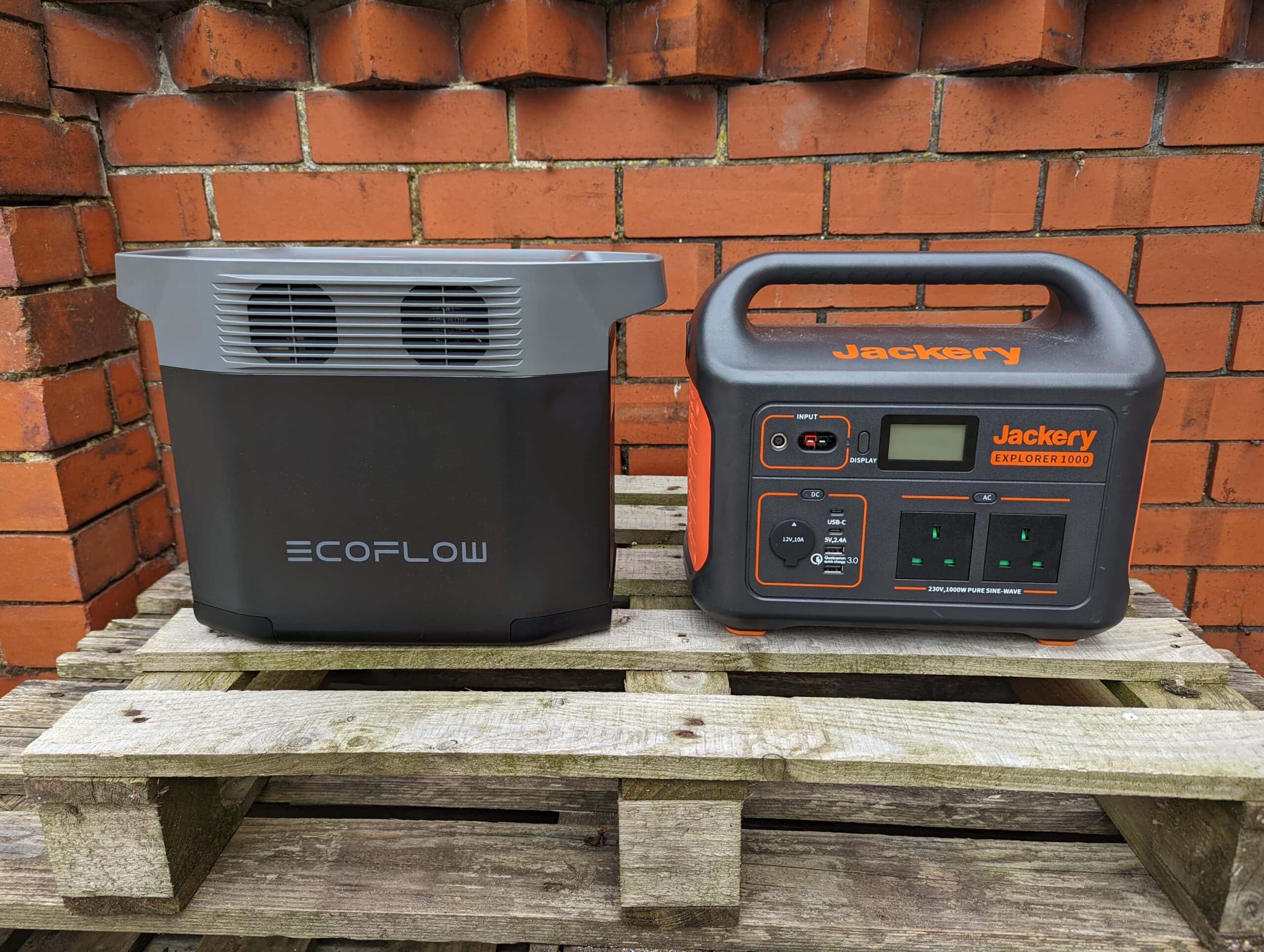




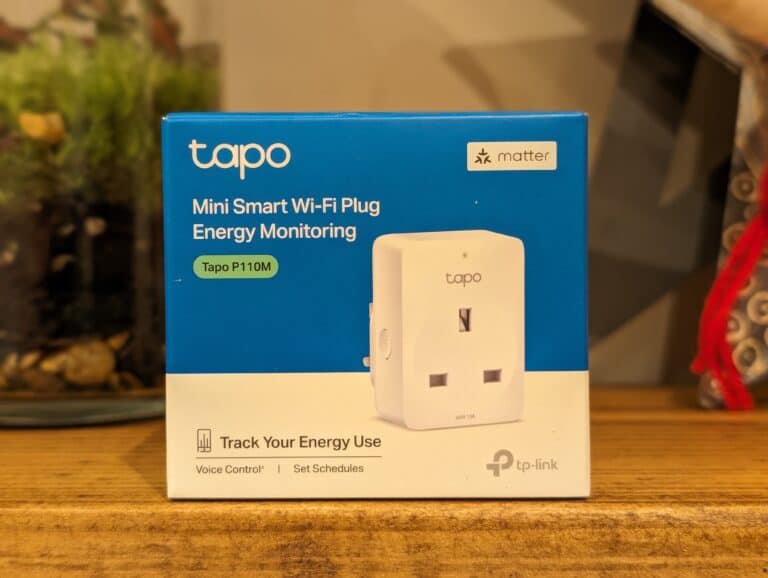
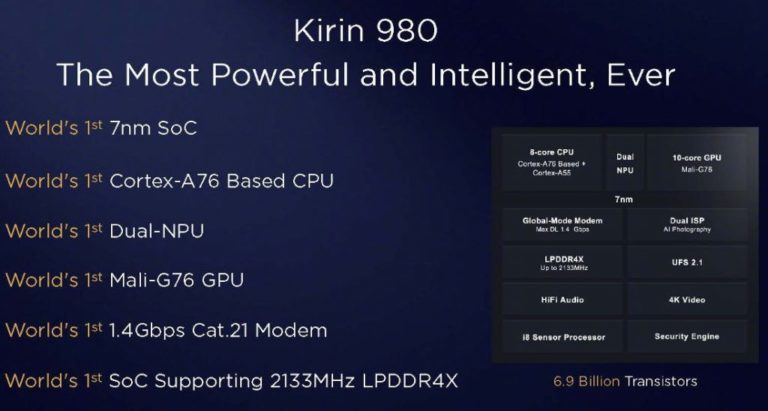

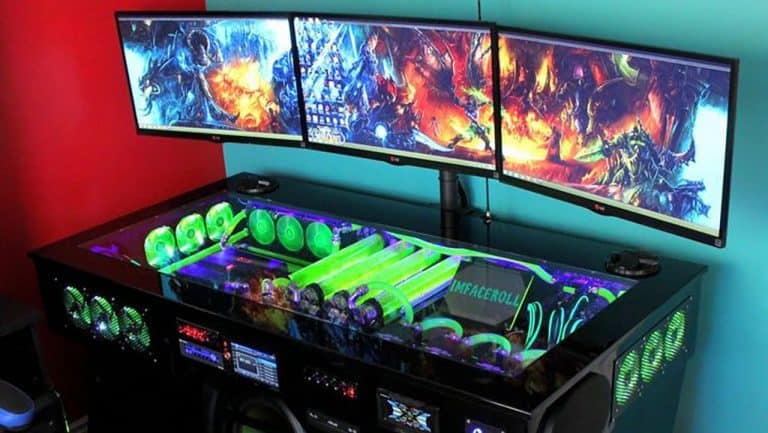
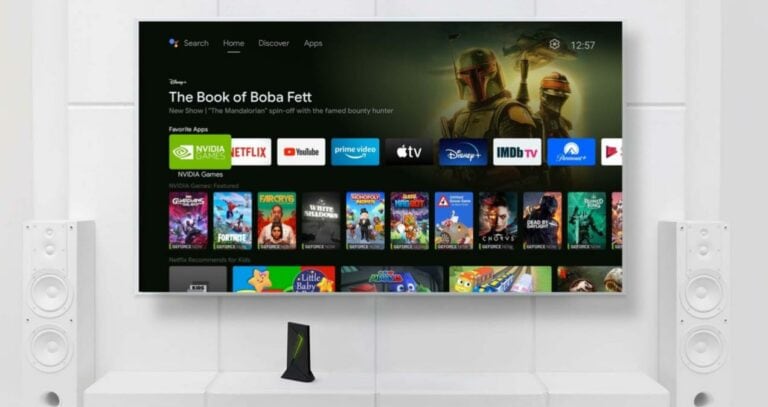
Geeat review.Do these not have 5 year warranty rather than 2?
Yes, it does! That wasn’t on the original spec sheet. You need to register it for the 5 years. Thanks for pointing that out.
Great review! Really helped me sort out the differences and benefits of Delta2, and make my final decision as I’ve been researching reviews. You gave great details and real examples. Thank you, SG
You missed a bit. The original has less ports, ports are not placed on the ends making it harder to stack side by side, is heavier, doesnt have two 100watt USB ports, n the end for reduction of space, is heavier, now has three prong sockets which is the ground/earth, doesnt have on and off switch for the dc port, doesnt have extra battery port for expandability and will not only add delta 2 batteries but Delta Max batteries fit too. So you can buy a Delta 2 with a Max battery and have over 3,000 watt hours and pay hundreds less than buying a Delta Pro that has 3,000 watt hours and it will weigh much less than the 100lb Pro. Original doesnt have X-Boost Technology that allows for 2,200 watt surge power before settling back to 1800watt continuous power. Original takes longer to charge. The Delta 2 is down to 80% charge at 50 min. Original cant talk to the mobile app and the Delta 2 can. Other than that, the two are identical.
Thanks for the comment, didn’t realise about the X-Boost Technology, that’s quite an important difference, thanks!
And who in their right mind is trying to sneak any powerstation into a cafe to charge. Just get the solar panels and charge for free.
Lots of van lifers apparently! Solar panels won’t provide all the charge if you are using this a lot – at least in the UK
Keep it charged through the car’s accessory port. That will take a bit longer but it takes longer to get anywhere in the UK anyway. My American truck has a US power socket so I can charge it on only a 50 minute drive. My Brit wife has solar in Warwickshire, so dont sell your country too short using the sun. Any of these three methods is better than lugging it into a cafe. lol.
I’m interested in using this unit for my hifi system to run it off battery power. I would be running my preamp, DAC, and streamer. They are rated at 140w combined consumption. Seems like this unit should have no issue powering these (I might even be find using the River2). I’m wondering if, when the battery gets low, the EcoFlow can still power the units while plugged in and recharging? Does that make sense? I know the Goal Zero Yeti does this and that’s another unit I’m looking at. I know this isn’t a typical use case, but thanks for the info.
Yes, it does this. It works as a UPS. When plugged in, it will recharge, but it will pass power directly to the devices themselves. It is only when power is cut off will the devices switch to the battery. The switch time is <=30ms, so you shouldn't notice anything as it switches over.One warning with using this and the River2 with audio is that they both had fans which can be moderately noisy, not ideal for audio. I think you should be OK when you are only pulling 140W, though.
Hi. Can you please tell me on a full charge, how long would a 1kw heater run with the Ecoflow Delta 2. Thanks
About 1 hour
My intention is to use Ecoflow Delta 2 when there is power cut. How long would the battery last to use gas boiler 42kw plus a fridge freezer and TV.